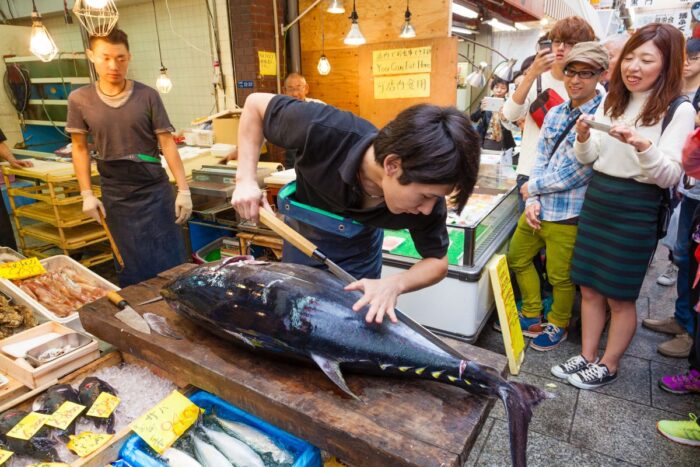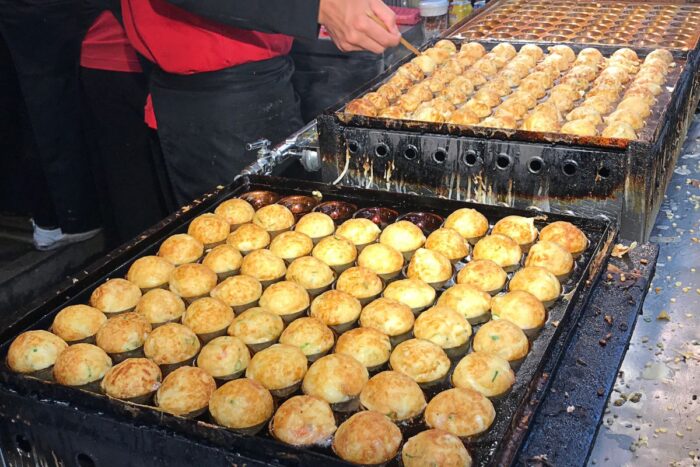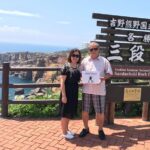Kuromon Market, also known as Kuromon Ichiba Market, is a popular destination for foodies in Osaka, Japan. This lively covered market stretches for 580 meters in Osaka’s hihonbashi, not far from dotonbori and is often referred to as “Osaka’s kitchen” due to the variety of fresh and local food available.
The market has a long history dating back to the Edo period and is home to around 150 shops that predominantly sell fish, meat, and produce, with other shops also offering traditional sweets and low-priced souvenirs.
You can sample local delicacies such as takoyaki, a ball-shaped snack filled with diced octopus, and fugu, a type of pufferfish that is considered a delicacy in Japan.

Key Takeaways
- Often referred to as “Osaka’s kitchen.”
- Has a long history dating back to the Edo period.
- Home to around 150 shops that predominantly sell fish, meat, and produce.
- You can sample local delicacies such as takoyaki and fugu.
- The market is open daily from early morning until late afternoon.
- Can get very crowded
History

The market has been in operation for over 190 years and has survived large fires and war attacks. The market used to be called Enmeiji Market since it was near the Enmeiji Temple, which had black gates (Kuromon in Japanese) and the market took on the nickname.
The name Kuromon came from the blackened (Kuro) gate (Mon) of the nearby Enmyoji Temple. This temple was destroyed in the great fire of 1912. After the fire, the market was rebuilt and expanded to include more shops selling goods.
Today, Kuromon Market is a popular destination for all. The market has about 150 shops that predominantly sell fish, meat, and produce, with other shops also purveying traditional sweets and low-priced clothes and homeware. The most famous fish at Kuromon Market are the conger pike in summer and Fugu in winter.
Location

Kuromon Market (黒門市場, Kuromon Ichiba) stretches for about 580 meters parallel to Sakaisujidori Street, making it easily accessible by public transportation.
The market is located near Nippombashi Station, which is only a few minutes walk away. It is also within walking distance of other popular attractions such as Dotonbori, Shinsaibashi, and Namba.
You can take the subway to Nippombashi Station, which is served by the Sennichimae Line and the Sakaisuji Line. Alternatively, you can take the Kintetsu Namba Line to Kintetsu Nipponbashi Station, which is also within walking distance of the market.
Layout
The market is divided into different sections, each with its own unique offerings. For example, the seafood section of the market is home to vendors selling fresh fish, shellfish, and other seafood delicacies, while the fruit and vegetable section offers a wide variety of fresh produce.
One of the unique aspects of Kuromon Market is that many of the vendors have been in business for generations, and some have been operating in the same location for over 100 years. This gives the market a sense of history and tradition that is hard to find elsewhere.
The layout of the market can be a bit confusing for first-time visitors and note that the market can also be quite crowded, especially on weekends and holidays, so be prepared to navigate through crowds of people as they explore the different sections of the market.
Foods and Products

Kuromon Market is known for its fresh and delicious seafood, meat, and produce. With around 150 shops, the market offers a wide range of food options that cater to different tastes and preferences. You can enjoy sushi, sashimi, grilled seafood, and other traditional Japanese dishes at numerous restaurants and food stalls.
Aside from the ready-to-eat food, Kuromon Market also offers take-home products that are perfect for cooking enthusiasts and foodies. Some of the popular products include:
- Matcha green tea and roasted hojicha tea
- Seasonings and spices for home cooking
- Dried food and pickled goods
- Japanese sweets and Western cakes
One of the must-try food items at Kuromon Market is the fresh oysters straight out of the shell. You can also indulge in creamy sea urchin (Uni), fatty tuna (Toro), and grilled scallops or scallops on a stick. For a unique culinary experience, try the fugu or blowfish, which is a delicacy in Japan.
Aside from the food, Kuromon Market also offers non-food products such as clothes, homeware, and souvenirs. You can find traditional Japanese clothing, kitchenware, and other unique items that make great gifts or mementos of the trip.
Overall, Kuromon Market is a food lover’s paradise that offers a diverse range of fresh and delicious food options. Whether you’re looking for a quick snack or ingredients for your next home-cooked meal, the market has Something to interest all.
Shopping Tips
If you’re planning to go shopping at Kuromon Market, here are a few tips to help make your experience more enjoyable:
- Bring cash with you, as many shops do not accept credit cards.
- Arrive early in the morning for the freshest produce and seafood. The market opens at 9am, but some vendors may start setting up as early as 6am.
- Try to avoid visiting on weekends or holidays, as the market can get very busy and crowded during these times.
It’s also worth noting that some shops may have different hours or be closed on certain days of the week, so it’s a good idea to check ahead of time if there’s a specific vendor you want to visit.
Finally, if you’re not sure what to buy or where to start, don’t be afraid to ask the vendors for recommendations or advice on whats in season.
How to Get There
Kuromon Market is located in the Nippombashi area of Osaka, Japan. Here are some options for getting there:
By Subway
The easiest way to get to Kuromon Market is by taking the subway. The market is just a few steps away from Nipponbashi Station on the Sennichimae and Sakaisuji subway lines. You can take either line and get off at Nipponbashi Station. From there, simply follow the signs to the market.
By Train
If you’re coming from outside of Osaka, you can take a train to Osaka Station and then transfer to the subway. From Osaka Station, take the Midosuji subway line to Namba Station and then transfer to the Sennichimae or Sakaisuji line to get to Nipponbashi Station.
By Bus
If you prefer to take the bus, there are several bus lines that stop near Kuromon Market. The closest bus stop is the Nipponbashi stop, which is serviced by the Osaka City Bus and the Kintetsu Bus. From there, it’s just a short walk to the market.
The Sum Up
Kuromon Market should be on your to-do-list for foodies and travelers looking to experience the local culture in Osaka. With over 150 shops selling fresh seafood, meat, produce, and traditional sweets, the market offers a unique and authentic taste of the city.
You can wander through the bustling aisles and sample some of the best street food in Osaka, including takoyaki, grilled scallops, and fresh sushi. The market is also a great place to shop for souvenirs and local products, such as Japanese knives and ceramics.
While the market can get crowded, especially on weekends and holidays, it’s worth braving the crowds for the experience. Be sure to bring cash, as many of the vendors don’t accept credit cards, and come hungry!





